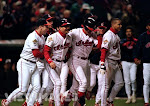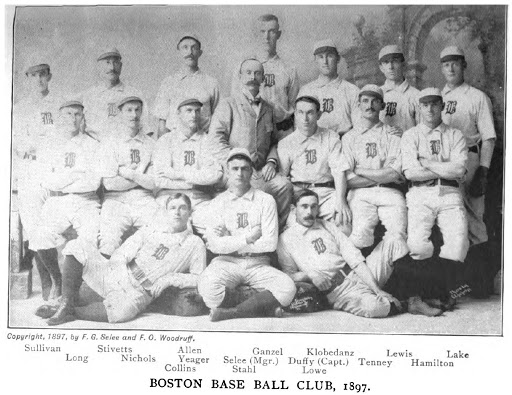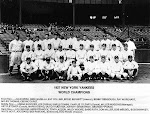I wanted to write a little bit, if only for myself, about each of the four teams added from the Federal League, which is the point of departure from the real baseball in our timeline. Well, that plus the fact that it's all simulated, and the computer is handling transactions as it sees fit save for the team I'm running...I mean, the whole thing would be different anyhow, but this is a big catalyst. There are four teams: the Baltimore Terrapins, Buffalo Blues, Kansas City Packers, and Newark Peppers.
I noted that I'm intending to write a post or two that generalizes about the factors that caused MLB to expand and teams to relocate. I'll include just a touch of my thoughts below, but only where relevant to the teams I'm discussing.
Baltimore: The Terrapins are clearly on the best footing of the expansion teams. They're owned by Ned Hanlon, a respected baseball man with Baltimore roots, who took things seriously enough that he sued MLB for antitrust violations, which ended up going all the way to the Supreme Court. The Terrapins have a perfectly good, new (if wooden) ballpark (Terrapin Park aka Oriole Park (V)), which was used all the way into the 1940s when it was destroyed by fire. Baltimore has a tradition of being a baseball town, and some of the greatest teams of all time (at least as of 1915) were the Baltimore Orioles of the 1890s, managed by Ned Hanlon (as it turns out), and well within living memory of many of Baltimore's adults. Baltimore itself was without a team since 1902 when the American League franchise folded and re-emerged in New York as the Yankees. Since the all-time great time was in the National League and since the AL has a team in Washington, I figured Baltimore made more sense as an NL addition. The team itself has also been playing pretty well, all told. The Federal League teams had to make do with their existing rosters, whatever free agents they could pick up, and whatever trades they could swing. They're middle of the pack in most team categories (but 2nd in home runs!). They have a 20-game winner in Jack Quinn, and picked up Chief Bender who is probably their ace. Guy Tuteiler is leading the NL in slugging percentage thanks no doubt to his 33 triples (!!), and Miller Huggins has an impressive 105 BB as a batter, also leading the league. Though not contending, the Terrapins have been just a bit below .500 most of the year, and they're currently 76-83 with 3 games to go, 21 games out of 1st place but 13 games ahead of the next team behind them, who are...
Buffalo: The Blues had a decent record in the Federal League in 1914 and real-life 1915. Here, they're in 8th place, and will finish there either alone or in a tie with the Cubs. The Blues, as I understand it, sold shares to the public, so I'm not 100% sure who their owner is. This will, I think, make relocating this team unlikely in the long run (assuming I get far enough that relocations become relevant)--while Buffalo may seem like an unlikely spot for an expansion team or relocation destination nowadays, in this universe it'll be like the Pirates or Reds, and Buffalo is in a completely reasonable geographic position to retain a team. They're 8th in the league in attendance (ahead of the Terrapins and Cardinals), but very close to Cincinnati in 7th place and not so far behind Brooklyn and the Cubs ahead of the Reds. The Blues' current park (the International Fair Association Grounds) is a bit of a problem for me, there's not a lot of information about it. Offermann Stadium would be built in 1924 out of concrete, I'm imagining in this timeline that will be moved up a bit. I put Buffalo in the NL mostly because that's what was left after thinking through the other teams. One could rationalize it by saying the NL didn't want the Great Lakes to just be an AL region (with Buffalo adding to Detroit and Cleveland), but really it's because it's what was left. Buffalo are a legit terrible team on offense, ranking last in the league in basically everything except home runs (they're 8th). Dave Davenport leads the team in WAR with 3.1, and has a 13-19 record to go with it.
Kansas City: The Packers had kind of a funny history in a few ways that I think are relevant here. They were slated to be purchased and moved to Newark (see below), but people intervened (I'd need to look to remind myself whether it was the city or team management) and kept the team in town. That combined with the way that their politicians reacted when the Athletics moved to Oakland makes me feel like this team will never move. The Packers' home park is Gordon and Koppel Field, but Muehlebach Field was built in 1923 for the minor league team and like Offerman Stadium I'm thinking it'll get built a bit sooner here. The Packers are currently in 7th, but could plausibly finish in 6th depending on how the last weekend of games goes. Like Buffalo, they're terrible at offense, and are in 10th place in most categories (but 4th in home runs!). Their pitching has been decent, however. Elmer Rieger has been their best pitcher, though before the trade deadline I would have written George McConnell--McConnell had accrued a 10-4 record with a 1.70 ERA with the Packers before the Athletics acquired him for a couple of young players. Kansas City hasn't drawn a ton of fans, but that may be a function of where I have their market size set. I could bump it up. For what it's worth, KC is in the AL because there's no history of an NL team in Kansas City and I just think of it as an AL town.
Newark: The worst team in the majors and one of the ones with the most question marks and potential influence on how this baseball world would evolve. When our story/league began, the Indianapolis team had just been purchased by Harry Ford Sinclair and moved to Newark. Perhaps I should have started while this team was still in Indianapolis, but I can rationalize that it was this move that forced the issue and led the leagues to make peace. In any case, the NYC area now has not three but four teams, though Newark is admittedly a bit further afield than Brooklyn from Manhattan. Naturally, rather than adding a 3rd NL team to the area, this meant that Newark had to be an AL team.
What I've run across about Sinclair suggests that he enjoyed being a team owner, and either he didn't lose money on the team in the Federal League or didn't care that he was losing money. I can't imagine he'd lose more money now that the Peppers were in the American League. In real life, Sinclair got embroiled in the Teapot Dome scandal in 1922, and after several years of legal trouble he ended up in jail in 1929. I have no reason to change any of this history, at least in the grand scheme. So, some time in the mid-1920s there's going to be a change of ownership because I can't imagine MLB being willing to have an owner in legal trouble like that in the 1920s. So, there will be an obvious decision point about what to do with the Peppers. If it were the mid-50s (or plausibly even the mid-30s) rather than the mid-20s, it'd probably be obvious that they'd bail out of Newark and head to Milwaukee (or LA or whatever). But for reasons that I plan to write a whole post about (probably the next one about the Alt-1915 league), I don't think that a team would necessarily relocate in the 1920s. But it's way too premature to speculate in any case--for all I know the Peppers are about to establish some amazing dynasty and eventually drive the Yankees out of New York rather than vice versa. A plausible future for the Peppers does include one where they end up at the Meadowlands or some stadium built where Newark Airport is or something.
As noted, the Peppers have the worst record in MLB, though they're only one game worse than the Cardinals. They have one real-life Hall-of-Famer on the team, Edd Roush, who's leading the team in batting average, slugging, and OPS. The pitching staff is "anchored" by Lefty Gervais, who is 10-24 with an ERA+ of 87 but still somehow has 3.7 WAR. In real life he had a total of 15.2 major league innings pitched in his career. He has 303.2 IP so far in Alt-1915.








